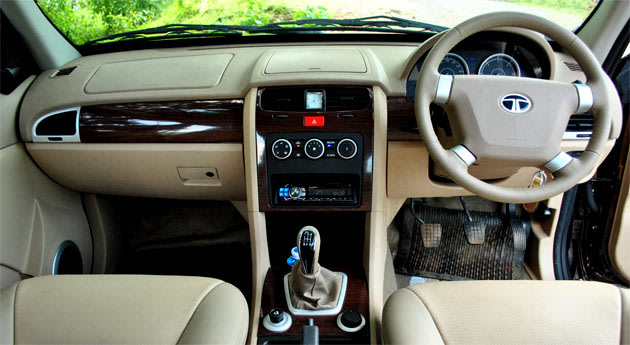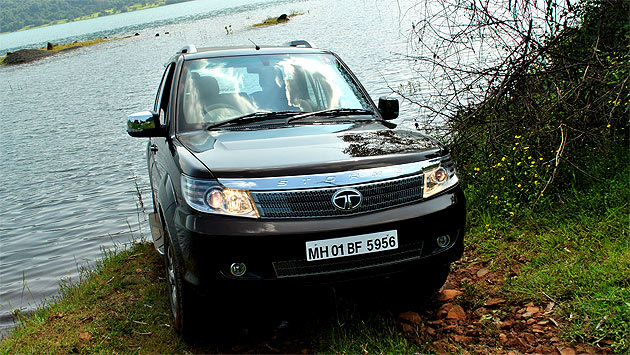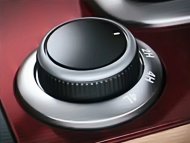When Tata introduced the Safari in 1998, it forged a radical new trend for the industry.
Soon, India's first 4X4 SUV became a household name and won the hearts of many enthusiasts.
But, over the Tata Safari's 14-year life span, there have been hardly any significant upgrades apart from two new engines and minor cosmetic changes.
A decade-and-a-half after it was launched, the Safari is still evolving. It finally got the long-awaited overhaul, but will the new Safari Storme be able to regain its past glory? Let us get on with the road test to find out.


Soon, India's first 4X4 SUV became a household name and won the hearts of many enthusiasts.
But, over the Tata Safari's 14-year life span, there have been hardly any significant upgrades apart from two new engines and minor cosmetic changes.
A decade-and-a-half after it was launched, the Safari is still evolving. It finally got the long-awaited overhaul, but will the new Safari Storme be able to regain its past glory? Let us get on with the road test to find out.
Design
There's no getting away from the fact that the Tata Safari looks majestic and has massive presence on the road. The new Safari Storme stays true to everything that made the original so fantastic from the beginning.
The Storme's exterior is very similar to the Safari and you'd be forgiven for thinking it's the same car in the first glance. But a closer look would reveal that the car has undergone some significant changes. The traditional smiley grille has been binned in favour of a more upmarket cheese-grater grille, crested with a 'STORME' engraved chrome strip.
Projector headlamps and a 'power bulge' on the bonnet add to the overall aesthetic appeal. In profile, the Storme has hardly anything new, barring the pull-type door handles, five-spoke alloy wheels and newly designed foot-steps. Moving to the rear, you would instantly notice that the tailgate-mounted spare wheel is gone -it's now placed under the body.
The tail lamps, spoilers, roof-rails are all new but what I really liked is the chrome-tipped twin exhaust pipes that boost the SUV's sporty feel.
Interiors
Sitting at a commanding position on board, you really are lord of all you survey. Now look around, there's virtually nothing carried over from the Safari. Tata has done a meticulous job of designing a minimalist, yet elegant cabin.
The leather-wrapped steering wheel is nice to hold but steering mounted controls are missing. I was surprised to notice that there's just a simple music player instead of the 2 Din audio system even on the top variant. But on the flip side, the music player is standard across all variants and it's Bluetooth enabled, too.

Space has always been Safari's forte and the Storme is no exception. The bolstered seats are supportive and road-trip pleasant.
The middle seat passengers have the comfort of AC vents both on the roof and the floor. However, the jump seats on the third row are strictly for those two unfortunate kids.
Performance, Ride and Handling
The most noteworthy changes are under the hood. The Safari Storme is powered by a 2.2 litre VariCOR engine, called so because it is turbocharged by Variable Turbine Technology (VTT).
An updated version of the 138bhp DiCOR, the engine delivers 140 PS of power and 320 NM of torque. Helping it along is an improved 5-speed manual gearbox and a 4X4 system.
The Storme rides on hydroformed ladder frame chassis that makes it 50 percent stiffer and 35kg lighter than the old Safari.

Weighing in at around two tonnes, the Storme is not a light vehicle and suffers accordingly below 1800rpm.
Despite the VTT, there isn't any apparent shift in power delivery, as it remains linear all the way to the redline. Once the turbo kicks in, the response is better and the vehicle cruises along with gusto, but any inclines require constant shifting of gears to keep the car on the boil.
The suspension is borrowed from the Aria and is on the soft side. The ride is very refined for a heavy vehicle but you pay for this with a fair amount of body roll in corners. The steering is vague anddoesn't self centre, too. The brakes work just fine, thanks to the disc brakes at all 4 wheels assisted by ABS on all variants.
The Safari Storme comes with good news for off-road enthusiasts. The top-end model features ESOF (electronic shift-on-fly) technology, enabling engagement of the 4x4 or 4X2 mode on the move, and is also equipped with a limited-slip differential. Tata had set up a terrapod track to explore the Storme's off-roading .
Although it took 14 long years, things have certainly got better with the Safari Storme. Meanwhile, competition had grown stiffer, too.
But Tata has got the main thing right — the price point. Starting from Rs 9.95 lakh for the entry-level trim, the Safari Storme is all set to face the competition and win its loyalists back.

Comments
Post a Comment